wheel OLDSMOBILE SILHOUETTE 1995 Owner's Guide
[x] Cancel search | Manufacturer: OLDSMOBILE, Model Year: 1995, Model line: SILHOUETTE, Model: OLDSMOBILE SILHOUETTE 1995Pages: 390, PDF Size: 20.27 MB
Page 232 of 390
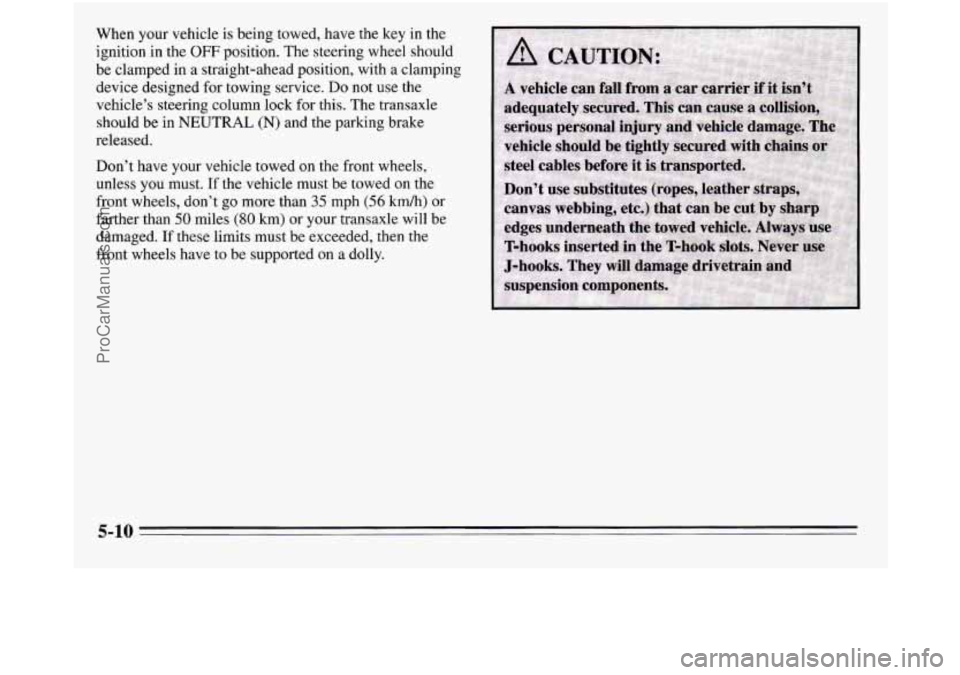
When your vehicle is being towed, have the key in the
ignition
in the OFF position. The steering wheel should
be clamped in a straight-ahead position, with a clamping
device designed for towing service.
Do not use the
vehicle’s steering column lock for this. The transaxle
should be in
NEUTRAL (N) and the parking brake
released.
Don’t have your vehicle towed on the front wheels,
unless you must.
If the vehicle must be towed on the
front wheels, don’t go more than
35 mph (56 km/h) or
farther than 50 miles (80 km) or your transaxle will be
damaged. If these limits must be exceeded, then the
front wheels have to be supported on a dolly.
5-10
ProCarManuals.com
Page 233 of 390
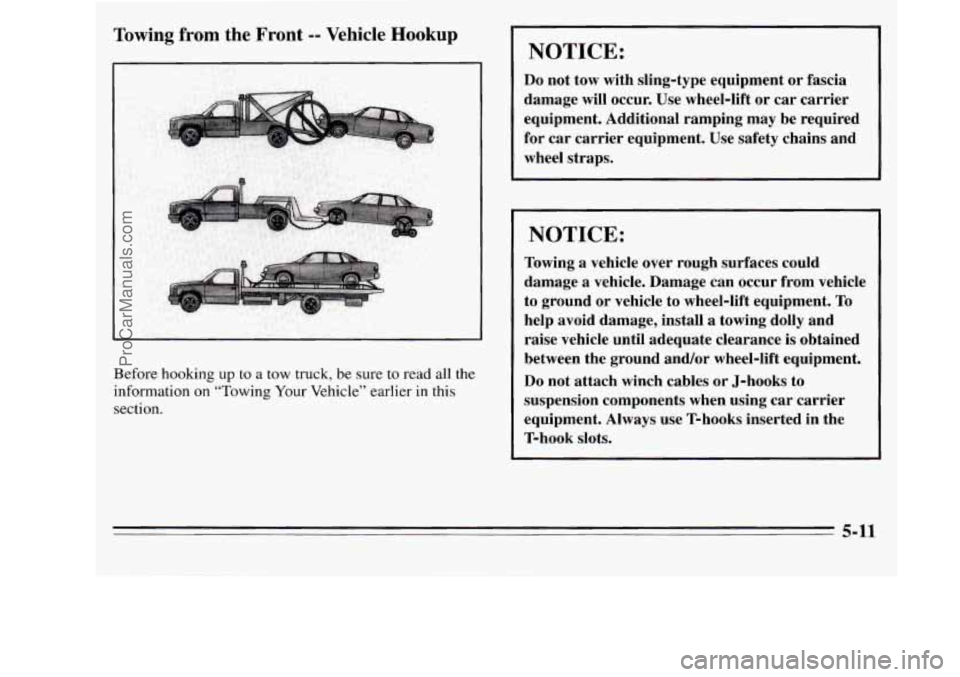
Towing from the Front -- Vehicle Hookup
Before hooking up to a tow truck, be sure to read all the
information
on “Towing Your Vehicle” earlier in this
section.
I NOTICE:
Do not tow with sling-type equipment or fascia
damage will occur. Use wheel-lift or car carrier
equipment. Additional ramping may be required
for car carrier equipment. Use safety chains and
wheel straps.
NOTICE:
Towing a vehicle over rough surfaces could
damage
a vehicle. Damage can occur from vehicle
to ground or vehicle to wheel-lift equipment. To
help avoid damage, install
a towing dolly and
raise vehicle until adequate clearance is obtained
between the ground and/or wheel-lift equipment.
Do not attach winch cables or J-hooks to
suspension components when using car carrier
equipment.
Always use T-hooks inserted in the
T-hook slots.
5-11
ProCarManuals.com
Page 234 of 390
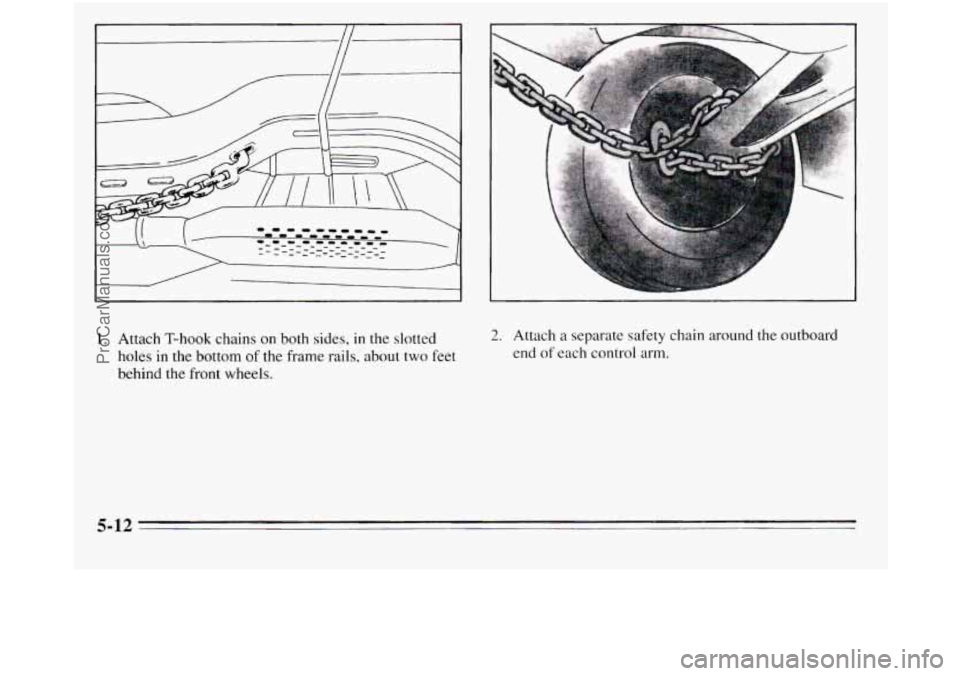
1. Attach T-hook chains on both sides, in the slotted
holes in the bottom
of the frame rails, about two feet
behind the front wheels.
6
L
2. Attach a separate safety chain around the outboard
end of each control
arm.
5-12
ProCarManuals.com
Page 235 of 390

Towing from the Rear -- Vehicle Hookup
Before hooking up to a tow truck, be sure to read all the
information on “Towing Your Vehicle” earlier in this
section.
1. Attach T-hook chains on both sides, in the slotted
holes in the frame rails, just ahead
of the rear wheels.
2. Position the lower sling crossbar directly under the
rear bumper.
No 4x4 wood beam is needed.
5-13
ProCarManuals.com
Page 236 of 390
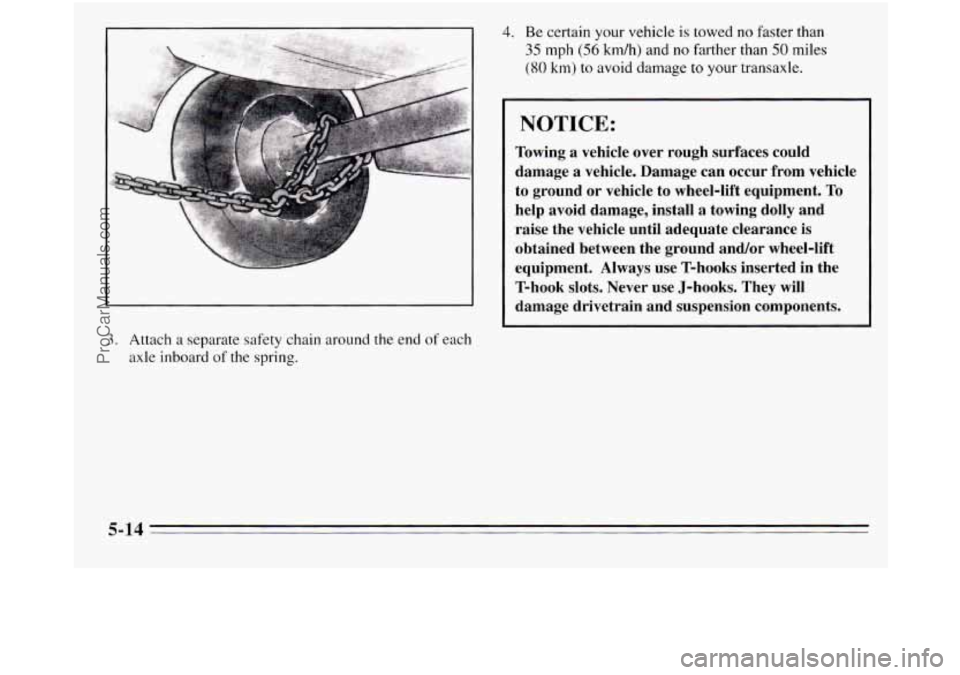
4. Be certain your vehicle is towed no faster than
35 mph (56 km/h) and no farther than 50 miles
(80 km) to avoid damage to your transaxle.
NOTICE:
Towing a vehicle over rough surfaces could
damage a vehicle. Damage can occur from vehicle
to ground or vehicle to wheel-lift equipment. To
help avoid damage, install a towing dolly and
raise the vehicle until adequate clearance is
obtained between the ground and/or wheel-lift
equipment. Always use T-hooks inserted in the
T-hook slots. Never use J-hooks. They will
damage drivetrain and suspension components.
3. Attach a separate safety chain around the end of each
axle inboard
of the spring.
5-14
ProCarManuals.com
Page 246 of 390
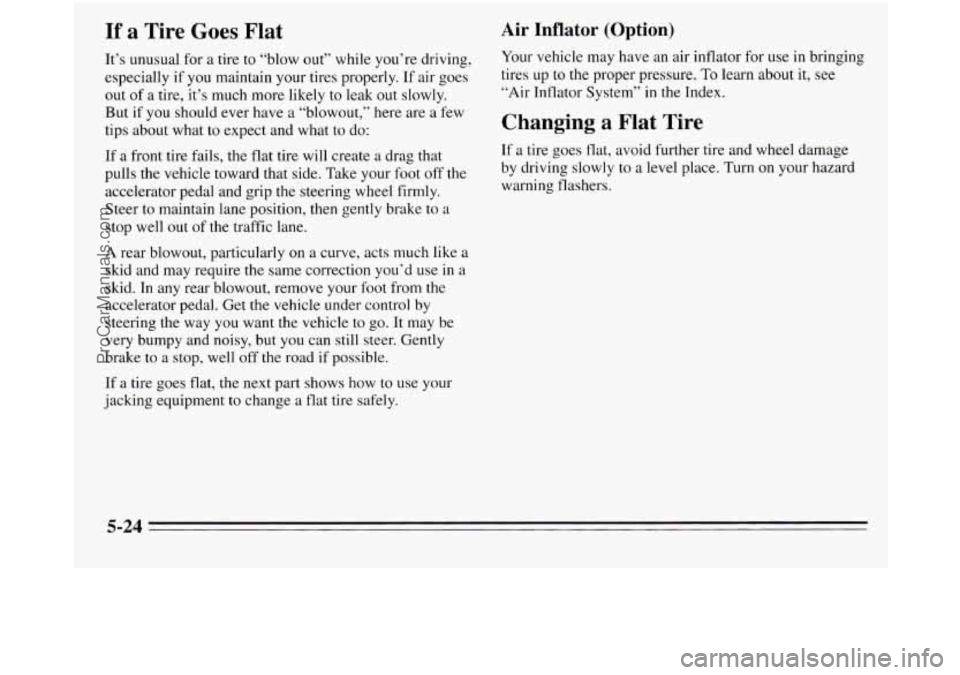
If a Tire Goes Flat
It’s unusual for a tire to “blow out” while you’re driving,
especially if
you maintain your tires properly. If air goes
out
of a tire, it’s much more likely to leak out slowly.
But if
you should ever have a “blowout,” here are a few
tips about what to expect and what to do:
If a front tire fails, the flat tire will create
a drag that
pulls the vehicle toward that side. Take your foot off the
accelerator pedal and grip the steering wheel firmly.
Steer to maintain lane position, then gently brake to
a
stop well out of the traffic lane.
A rear blowout, particularly on a curve, acts much like a
skid and may require the same correction you’d use in a
skid. In any rear blowout, remove your foot from the
accelerator pedal. Get the vehicle under control by
steering the way you want
the vehicle to go. It may be
very bumpy and noisy, but you can still steer. Gently
brake to a stop, well
off the road if possible.
If
a tire goes flat, the next part shows how to use your
jacking equipment
to change a flat tire safely.
Air Inflator (Option)
Your vehicle may have an air inflator for use in bringing
tires up to the proper pressure.
To learn about it, see
“Air Inflator System’’ in the Index.
Changing a Flat Tire
If a tire goes flat, avoid further tire and wheel damage
by driving slowly to
a level place. Turn on your hazard
warning flashers.
5-24
ProCarManuals.com
Page 250 of 390

n 74
LIII
I.
A
7. Each wheel nut is covered with a nylon cap. Use the
folding wrench to remove the nylon caps from the
wheel nuts before
you loosen the nuts.
8. Loosen the wheel nuts -- but do not remove
them
-- using the folding wrench.
5-28
ProCarManuals.com
Page 251 of 390
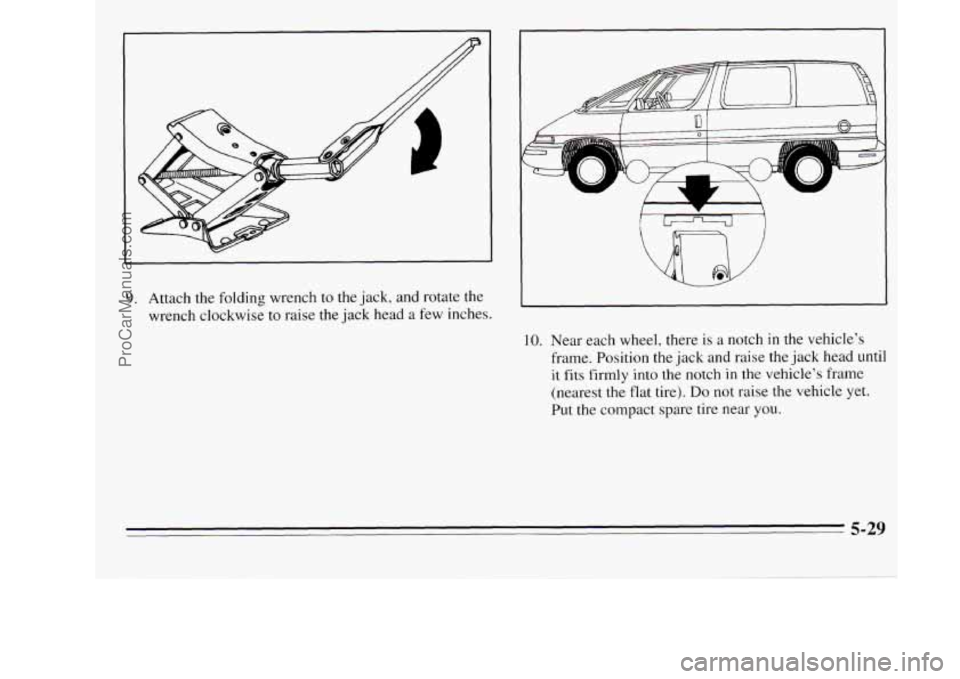
9. Attach the folding wrench to the jack, and rotate the
wrench clockwise to raise the jack head a few inches.
I L L.
Gn J
IO. Near each wheel, there is a notch in the vehicle's
frame. Position the jack and raise the jack head
until
it fits firmly into the notch in the vehicle's frame
(nearest the flat tire).
Do not raise the vehicle yet.
Put the compact spare tire near you.
5-29
ProCarManuals.com
Page 252 of 390
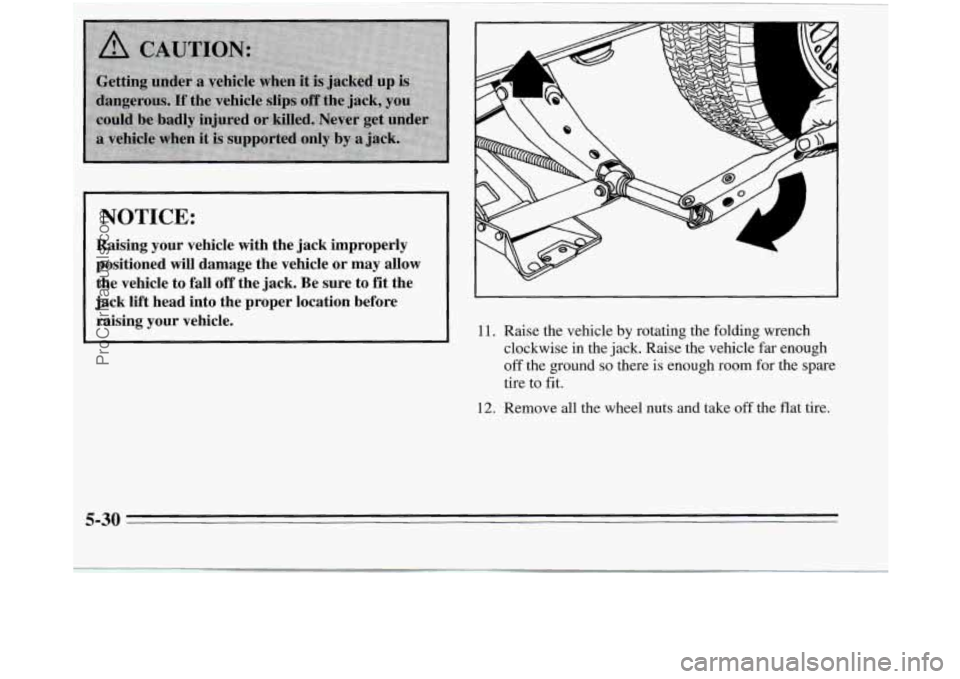
NOTICE:
Raising your vehicle with the jack improperly
positioned will damage the vehicle or may allow the vehicle
to fall off the jack. Be sure to fit the
jack lift head into the proper location before
raising your vehicle.
11. Raise the vehicle by rotating the folding wrench
clockwise in the jack. Raise the vehicle far enough
off the ground so there is enough room for the spare
tire to fit.
12. Remove all the wheel nuts and take off the flat tire.
I
' 5-30
ProCarManuals.com
Page 253 of 390
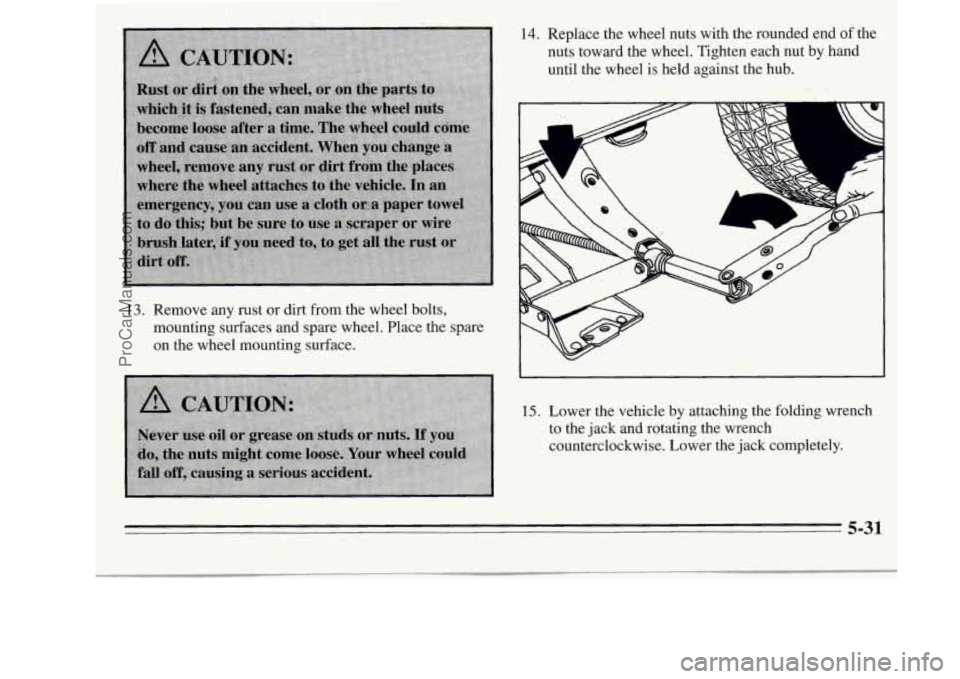
13. Remove any rust or dirt from the wheel bolts,
mounting surfaces and spare wheel. Place the spare
on the wheel mounting surface.
14. Replace the wheel nuts with the rounded end of the
nuts toward the wheel. Tighten each nut by hand
until the wheel is held against the hub.
15. Lower the vehicle by attaching the folding wrench
to the jack and rotating the wrench
counterclockwise. Lower the jack completely.
ProCarManuals.com